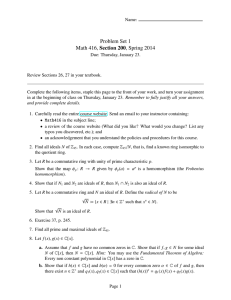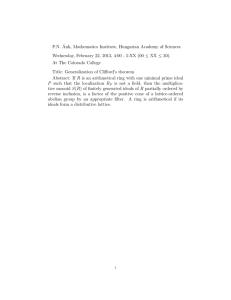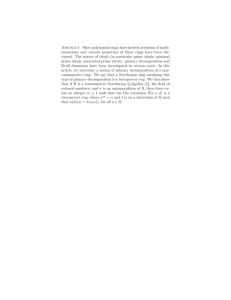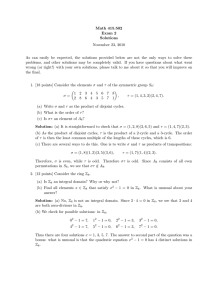Problem Set #2
advertisement
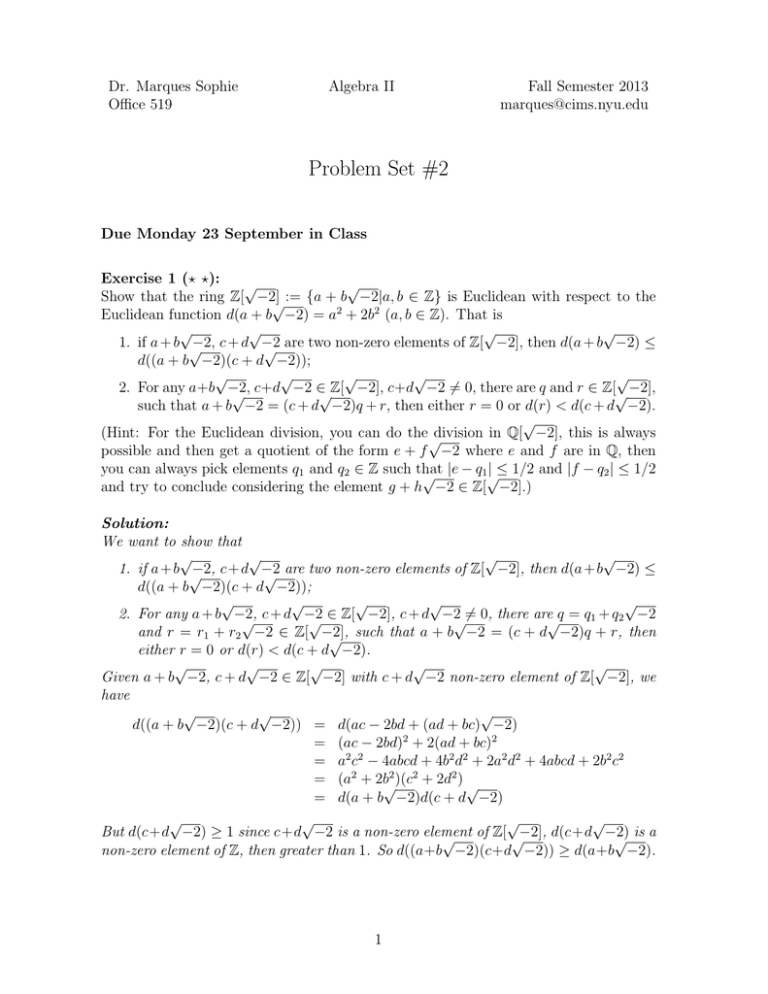
Dr. Marques Sophie
Office 519
Algebra II
Fall Semester 2013
marques@cims.nyu.edu
Problem Set #2
Due Monday 23 September in Class
Exercise 1 (? ?):
√
√
Show that the ring Z[ −2]
:=
{a
+
b
−2|a, b ∈ Z} is Euclidean with respect to the
√
Euclidean function d(a + b −2) = a2 + 2b2 (a, b ∈ Z). That is
√
√
√
√
1. if a + b √
−2, c + d −2
are
two
non-zero
elements
of
Z[
−2],
then
d(a
+
b
−2) ≤
√
d((a + b −2)(c + d −2));
√
√
√
√
√
2. For any a+b −2,
c+d
−2
∈
Z[
−2],
c+d
−2
=
6
0,
there
are
q
and
r
∈
Z[
√
√
√ −2],
such that a + b −2 = (c + d −2)q + r, then either r = 0 or d(r) < d(c + d −2).
√
(Hint: For the Euclidean division, you can do the√division in Q[ −2], this is always
possible and then get a quotient of the form e + f −2 where e and f are in Q, then
you can always pick elements q1 and q2 ∈ Z such that
| ≤ 1/2 and |f − q2 | ≤ 1/2
√ |e − q1√
and try to conclude considering the element g + h −2 ∈ Z[ −2].)
Solution:
We want to show that
√
√
√
√
1. if a + b √
−2, c + d −2
are
two
non-zero
elements
of
Z[
−2],
then
d(a
+
b
−2) ≤
√
d((a + b −2)(c + d −2));
√
√
√
√
√
2. For any a + b −2,
c
+
d
−2
∈
Z[
−2],
c
+
d
−2
=
6
0,
there
are
q
=
q
+
q
−2
1
2
√
√
√
√
such
that
a
+
b
−2
=
(c
+
d
−2)q
+
r,
then
and r = r1 + r2 −2 ∈ Z[ −2],
√
either r = 0 or d(r) < d(c + d −2).
√
√
√
√
√
Given a + b −2, c + d −2 ∈ Z[ −2] with c + d −2 non-zero element of Z[ −2], we
have
√
√
√
d((a + b −2)(c + d −2)) = d(ac − 2bd + (ad + bc) −2)
= (ac − 2bd)2 + 2(ad + bc)2
= a2 c2 − 4abcd + 4b2 d2 + 2a2 d2 + 4abcd + 2b2 c2
= (a2 + 2b√2 )(c2 + 2d2 ) √
= d(a + b −2)d(c + d −2)
√
√
√
√
But d(c+d −2) ≥ 1 since c+d −2 is a non-zero element
of
Z[
−2],
d(c+d
−2)
√
√
√ is a
non-zero element of Z, then greater than 1. So d((a+b −2)(c+d −2)) ≥ d(a+b −2).
1
√
√
√
√
Now, suppose we are given a + b −2, c + d −2 ∈ Z[ −2] with c + d −2 6= 0. Then,
√
a+b√−2
c+d −2
√
√
−2)
= (a+b −2)(c−d
c2 +2d2
√
ad+bc
= cac−2bd
2 +2d2 + c2 +2d2
√
√−2
= e + f −2 ∈ Q[ −2]
As suggested we can pick q1 , q2 ∈ Z such that |e − q1 | ≤ 1/2 and |f − h| ≤ 1/2 and set
√
q = q1 + q√2 −2
√
r = a + b −2 − q(c + d −2)
√
√
Then a + b −2 = q(c + d −2) + r and
√
√
d(r) = d((c + d√ −2)((e − g) + (f − h) √
−2))
= d(c + d√−2)d((e − q1 ) + (f − q2 ) −2)
2
+ 2(1/2)2 )
≤ d(c + d −2)((1/2)
√
≤ 3/4d(c +
√ d −2)
< d(c + d −2)
Exercise 2(?):
Compute the euclidean division of g = x5 + x2 − x − 1 by f = x3 − x2 + x + 1 in Q[x].
Solution:
(Note: division of polynomials is done in different styles in different cultures, you need
not have used precisely the method above.)
x5 + x2 − x − 1 x3 − x2 + x + 1
−(x − x4 + x3 + x2 ) x2 + 1
x4 − x3 − x − 1
4
−(x − x3 + x2 + x)
−x2 − 2x − 1
5
Then,
x5 + x2 − x − 1 = (x2 + x)(x3 − x2 + x + 1) − (x + 1)2
Exercise 3 (?):
Show that the polynomial 1 + x + x3 + x4 is not irreducible over any field.
Solution:
1 + x + x3 + x4 = 1 + x + x3 (1 + x) = (1 + x)(1 + x3 )
So, 1 + x + x3 + x4 is not irreducible over any field
Exercise 4 (??):
Let R = Q[x]/(x3 −x2 −x+1). Determine all ideals of R. (Hint: Factor x3 −x2 −x+1 and
use the following theorem of the course, taking R = Q[x] and R0 = Q[x]/(x3 −x2 −x+1):
2
Theorem Let R, R0 be rings and φ a surjective homomorphism of R to R0 with kernel
U . Then, R0 is isomorphic to R/U . Moreover, there is a one to one correspondence Φ
between the set of ideals of R0 and the set of ideals of R which contains U . For W 0 an
ideal of R0 , we set Φ(W 0 ) to be the ideal {x ∈ R|φ(x) ∈ W 0 } and for an ideal W of R
which contains U , we set Φ−1 (W ) = W/I. )
Solution:
Let I =< x3 − x2 − x + 1 >. Note that x3 − x2 − x + 1 = (x − 1)2 (x + 1) over Q.
Note further that Q[x] is a principal ideal domain, as Q is a field. Therefore there are
exactly 6 ideals of Q[x] containing I. Namely, they are
I, < (x − 1)2 >, < (x − 1)(x + 1) >, < (x + 1) >, < (x − 1) >, and Q[x]
By the correspondence Theorem, there is a one-to-one bijective correspondence between
the ideals of Q[x] containing I and the ideals of Q[x]/I. If J is an ideal of Q[x]
containing I, then the corresponding ideal of Q[x]/I is given by J/I. Therefore, there
are exactly 6 ideals of Q[x]/I, which are
I/I = {0}, < (x−1)2 > /I, < (x−1)(x+1) > /I, < (x+1) > /I, < (x−1) > /I, and Q[x]/I
Exercise 5 (??):
Let F be a field of characteristic p for some prime p.
1. Show that φ : F → F defined by φ(x) = xp is a ring homomorphism. (The
hardest part is to show φ preserves sums!)
2. If F is finite, show that φ is an automorphism. (Note: Even if you don’t get part
1 you can do this part assuming part 1.)
Solution:
1. To show that φ is a ring homomorphism, we must show that φ is additive and
multiplicative. First note that since
p!
k!(p − k)!
for all k ∈ {1, 2, ..., p − 1}. Therefore p| kp for all 1 ≤ k ≤ p − 1.
Therefore,
P
p p−k k
b + bp
φ(a + b) = ap + p−1
k=1 k a
p
p
= a + 0 + b = φ(a) + φ(b)
p|
for all a, b ∈ F since F has characteristic p. So φ is additive. Also φ is multiplicative since
φ(ab) = (ab)p = ap bp = φ(a)φ(b)
for all a, b ∈ F since F is commutative. Therefore φ is a ring homomorphism.
3
2. Now assume F is finite. Note that Ker(φ) = {0} as if ap = 0 then a = 0, as F
has no zero-divisors. So φ is an injection. Now since F is finite, we may conclude
that φ is actually an isomorphism, as the domain and codomain have the same
cardinality. So φ is a ring automorphism.
1
1
(?) = easy , (??)= medium, (???)= challenge
4
